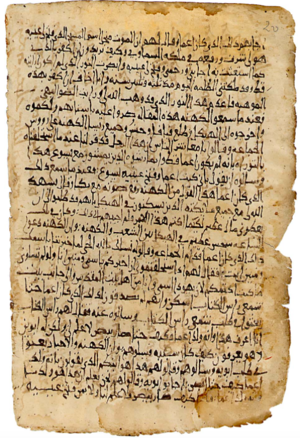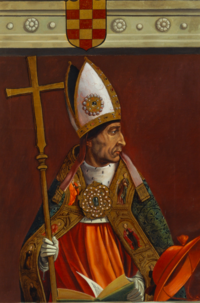Gospel of Andrew
| Gospel of Andrew | |
|---|---|
 | |
| Information | |
| Religion | Christianity |
| Author | Unknown (Attributed to Andrew) |
| Language | Deltinian |
| Period | c. 1200s–early 1300s |
| Chapters | 4 |
| Verses | 49 total |
The Gospel of Andrew (Deltinian: إنجيل أندراوس; transliterated as: iinjil andarawus; Creeperian – Creeperian: Եվանգելիո դե Անդրէս; Creeperian – Iberic: Evangelio de Andrés), also sometimes called the Gospel of the Deltinians (Creeperian] – Creeperian: Եվանգելիո դե լոս'Դելտինիանոս; Creeperian – Iberic: Evangelio de los'Deltinianos) in Creeperopolis, is a non-canonical Christian gospel which claims to depict the birth, death, and resurrection of Jesús, as well as record several of his sayings which he reportedly said during his ministry. Despite being attributed to the Apostle Andrew, the gospel has been dated to have been written sometime during the 13th to early 14th centuries during the Creeperian Crusade in Sur.
The gospel was first mentioned in 1329 by Cardinal Adémar Puyal Cisneros in an edict denouncing the text as pseudepigraphical, heretical work. The original text was written in Deltinian Arabic, instead of Old Arabic from 1st century Hejaz, which helped identify the work as a non-original 1st century work. The gospel was ordered to be destroyed by Puyal Cisneros, and for centuries, it was thought to be a lost work, however, the original text was discovered in the underground archives of the Cathedral of San Miguel the Liberator in La'Victoria in 1955. The gospel was copied and translated and has since been preserved and put on display in the Museum of National Creeperian History in San Salvador.
The Gospel of Andrew is the newest New Testament apocrypha which has been formally denounced and suppressed by the Creeperian Catholic Church. After its rediscovery in 1955, the Church blocked efforts to copy and translate the text. The Church finally allowed the Ministry of Internal Affairs to copy, translate, and preserve the Gospel of Andrew in 1957 with the approval of Pope Pío XII.
Contents
Textual history
Condemnation and ordered destruction

The first mention of the Gospel of Andrew occurred in 1329 in an edict written by then Cardinal of La'Victoria, Adémar Puyal Cisneros, who denounced the text as a heretical work and as pseudepigraphical, stating that the text is not an original work from the 1st century, but instead, that it is a forgery written sometime in the 1200s or early-1300s. His edict cited several verses within the text which contradicted the canon of the four canonical gospels of the Creeperian Catholic Bible: Matthew, Mark, Luke, and John. The edict also cited that the text was written in Deltinian, instead of Old Arabic from 1st century Hejaz.
Puyal Cisneros ordered the text to be destroyed in his edict, and the text was not mentioned again in any other document from the era. The text was next mentioned in the 1645 book Historia de la'Biblia by Simeón Cañas Villacorta, the first rector of the University of Nuevo Xichútepa, which briefly mentioned the existence of the gospel and the edict issued by Puyal Cisneros denouncing it. In the book, Cañas Villacorta stated that: "any hopes of finding the original contents of the so-called 'Gospel of Andrew' are effectively none as it was destroyed on orders of Cardinal Saint Adémar Francisco Puyal Cisneros and was likely never copied."
After its mentioning by Cañas Villacorta, interest in the Gospel of Andrew within college and university circles grew, with several students and professors theorizing what the contents of the gospel could have possibly been. Outside of academia, the Gospel of Andrew remained an obscure, long-lost, Crusade-era heretical text which the average Creeperian had no knowledge of, mostly as a result of its suppression by the Creeperian Catholic Church and the restriction of the spread of information by the Creeperian government.
Rediscovery, translation, and preservation
In 1955, during renovations of the Cathedral of San Miguel the Liberator in La'Victoria, a group of workers found a locked box in the underground archives of the cathedral labelled "Evangelio de Herejía–Andrés" (Gospel of Heresy–Andrew). The box was removed and brought to the attention of the Bishop of La'Victoria, José Galván Salinas, who ordered the opening of the box. Upon its opening, several pages written in Arabic were uncovered, and upon acquiring a translator, the book was confirmed to be the thought-to-be lost Gospel of Andrew. Galván Salinas announced the discovery on 17 October 1955, which caused controversy within the hierarchy of the Creeperian Catholic Church. The Ministry of Internal Affairs was interested in acquiring possession of the text, copying it, translating it, and preserving it, however, the ministry was denied by the Church, which wanted to dispose of the work as was originally ordered by Puyal Cisneros in 1329.
After two years, Pope Pío XII granted his official approval to the Ministry of Internal Affairs to copy, translate, and preserve the work in order to further learn and understand the history of the Crusade-era Church. The Gospel of Andrew was translated between 1957 and 1959 by translators José Maricón Figueroa and Augusto Ferrer Galdámez. The original text was kept private by the ministry until 1980, when it was placed into a display case in the Museum of National Creeperian History in San Salvador, where it presently remains on display. After an attack on various objects in the museum in 1989, bulletproof glass was installed where the Gospel of Andrew was displayed.
Comparison to the four canonical gospels
| Item | 4 canonical gospels | Gospel of Andrew |
|---|---|---|
| New Covenant | Central theme | Not mentioned |
| Forgiveness | Very important | Important, but damnation also emphasized |
| The Lord's Prayer | Mentioned | Not mentioned |
| The Beatitudes | Mentioned | Mentioned |
| The Greatest Commandment | Mentioned | Not mentioned |
| Jesus' ministry | Recounted | Sayings mentioned |
| Disciples-number | Twelve | Not mentioned |
| Virgin birth account | Mentioned | Mentioned |
| Jesus' baptism | Recounted | Mentioned |
| Preaching style | Parables | Sayings |
| Storytelling | Parables | Not present |
| Miracles | Many miracles | Not present |
| Duration of ministry | Three years | Not mentioned |
| Location of ministry | Hejaz | Not mentioned |
| Arrest | Mentioned | Not mentioned |
| Before Pilate | Mentioned | Not mentioned |
| Carrying of the cross | Mentioned | Not mentioned |
| Crucifixion | Mentioned | Mentioned |
| Resurrection | Mentioned | Mentioned |
| Ascension | Mentioned | Not mentioned |
Author
The author of the Gospel of Andrew is unknown as it was published anonymously under the pseudepigraphic name Andrew, in reference to Saint Andrew, one of the twelve Apostle of Jesús. The author is presumed to be a Creeperian who had knowledge of the Deltinian Arabic language, or possibly even a Deltinian in an effort to negatively affect the Creeperian Catholic Church in some sort of way. In his edict denouncing the Gospel of Andrew, Puyal Cisneros excommunicated the text's author.
